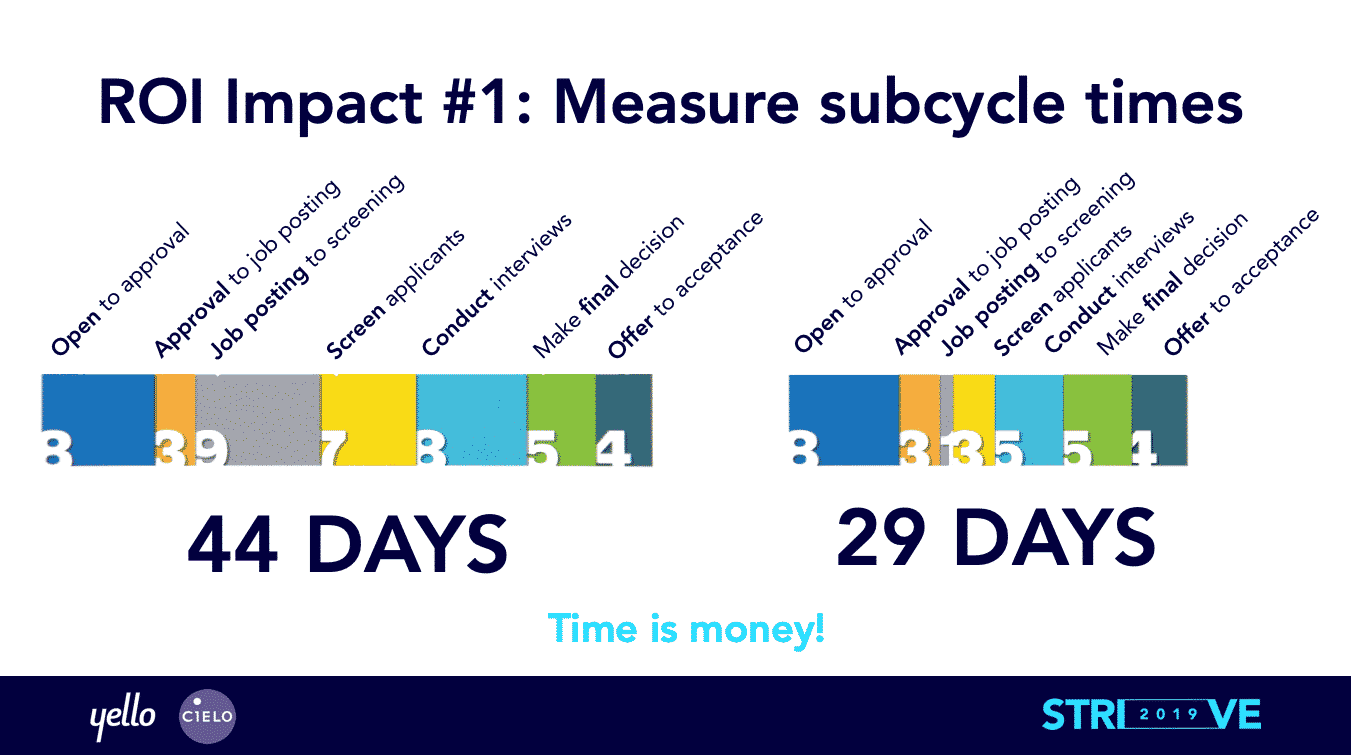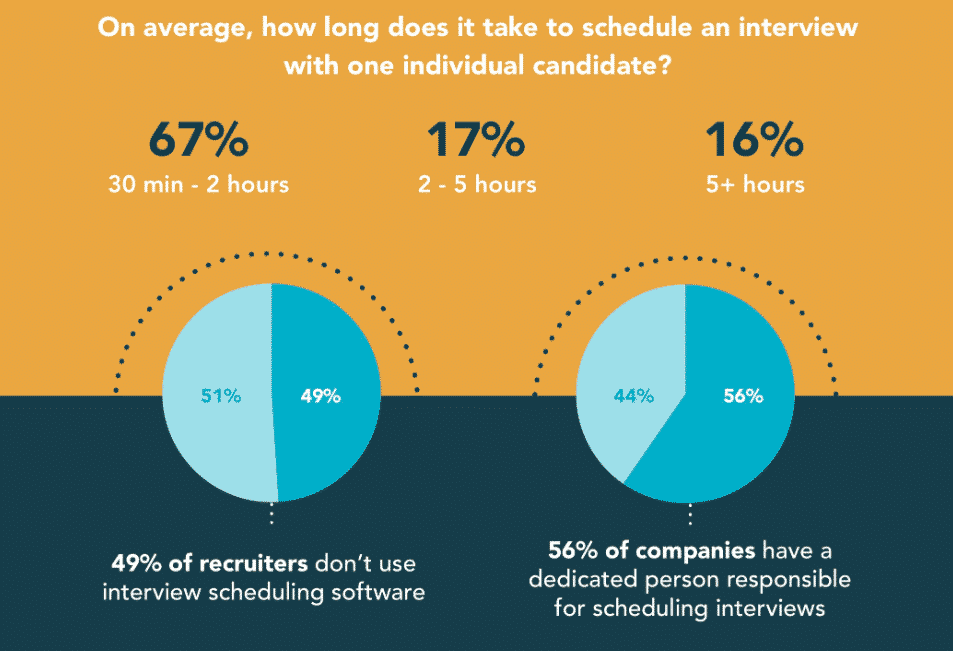The Ultimate Guide to Recruitment Operations
We’re breaking it down step-by-step, from a common definition for recruitment operations to which metrics you should be tracking.
Key insights include:
- What is recruitment operations?
- Defining the hiring process
- Common recruitment operations challenges
- The impact of interview scheduling on recruiting operations
- How to build a recruitment operations team
- Measuring and maximizing recruitment KPIs
- Benefits of recruitment operations software
- How to manage a recruiting budget
- The future of recruitment operations
What is Recruitment Operations?
“Talent acquisition is quite literally our business. Anytime we’re not operationally excellent — we forget to call a candidate back, we let somebody fall out — that’s money that’s gone.”
Recruitment operations professionals can also help their companies prepare for the future of work by anticipating industry trends, combating global talent shortages and identifying how other external forces may affect the company.

Learn more about the basics of recruitment operations.
Defining the Hiring Process
A key function of recruitment operations is defining each step in the hiring process to identify where there might be inefficiencies or areas of improvement.
Do you know how long each phase of your recruitment funnel takes?

There are so many steps to filling an open role that the answer can be different depending on the company. Take the time to break down each phase in your hiring process: from posting a new job to screening applicants to scheduling interviews, making a final decision and extending an offer. There are plenty of opportunities to speed up the process if you can identify where your time-to-hire is slowing down.
Here’s a recruitment process checklist to get you started:
The Start-to-Finish Recruitment Process Checklist
- Put a hiring plan in place
- Identify your main sourcing channels
- Create and publish your job posting
- Make it easy to apply
- Promote the open position
- Screen candidates and create your shortlist
- Prepare for the interview
- Schedule & conduct interviews
- Assess candidates
- Communicate with candidates post-interview
- Make an offer and close the deal
- Prepare pre-boarding materials
- Conduct new employee onboarding
- Analyze results
No matter how you define your organization’s hiring process, the focus should be on providing a more positive candidate experience. Application procedures must be smooth and painless. Screening must be seamless and swift. Interview scheduling, often the log jam of the hiring process, must be updated to reduce lag and bring in talent quickly, before the competition does.
Are you following a step-by-step recruitment process checklist?
Common Recruitment Operations Challenges
Today’s tight market conditions make recruitment operations challenging for all businesses, but pain points in the process can exacerbate the issue.

Interview scheduling is typically the biggest issue for recruitment operations. Manually scheduling interviews can be an endless loop of phone calls, texts and emails, juggling timetables and rescheduling. Not only is it a significant administrative burden for your recruiting team, but it can often give job seekers the impression that your organization is low-tech or disorganized, leading to candidate drop-off.

Slow or ineffective candidate screening is often another problem in the hiring process. Manual screening of applications or resumes is a time-consuming method that can be fraught with errors as well as conscious and unconscious bias. Technology has addressed this problem, with most companies using screening tech to assure the best quality candidates make it through. Failing to use available screening tools puts business behind the competition with regard to speed as well as building a diverse and inclusive workplace.

Candidate sourcing can also be a challenge for recruiting teams with high-volume hiring needs. Filling talent pipelines, attending recruiting events and encouraging employee referrals are all great ways to find talent, but they can take significant time and resources to execute. For many organizations, looking for candidates can often be one of the most lengthy steps in the process.
Overcome your operational hiring issues in 6 steps.
The Impact of Interview Scheduling on Recruiting Operations
Scheduling candidates for interviews is by far the biggest drain on resources during the hiring process, and is often the culprit when it comes to a lengthy time-to-hire. Interview scheduling is too often a back-and-forth hassle of connecting, finding available times, scheduling and rescheduling that not only takes recruitment teams too much time, but puts them at risk of losing candidates who grow frustrated by a lengthy process.
Recruiters are spending ⅔ of their overall hiring time on the interview process.
A majority of recruiters say interview scheduling takes them 30 minutes to 2 hours per candidate, which adds up quickly for companies who are hiring dozens or hundreds of candidates per year.

Source: Yello 2020 Interview Scheduling Survey
Finding ways to cut down on interview scheduling time makes for a smoother operations process for the whole recruitment team, as well as a more positive experience for candidates.
Technology is the answer. And it’s a growing trend: 51% of recruiters are already using interview scheduling software, with another 26% thinking about starting. What’s more, 59% of recruiters who use interview scheduling software say they’ve saved between 2 and 10 hours per week.
59% of recruiters who use interview scheduling software say they’ve saved between 2 and 10 hours per week.
Optimizing the interview process is the #1 thing recruitment operations professionals can do to speed up time-to-hire.
How to Build a Recruitment Operations Team
Because recruitment operations is such a new function for most talent acquisition teams, there’s still no defined best practice for what a recruitment operations staff looks like.
Some companies are incorporating recruitment operations strategies into their existing efforts, asking recruiters to continue identifying, engaging, interviewing and hiring employees while increasing focus on data-driven decisions and incremental process improvements.
At the other end, many companies have introduced entirely new recruitment operations staff, with the sole purpose of creating and executing a strategy to improve hiring processes, fill roles more quickly, decrease costs and generally improve recruiting ROI.
While recruitment ops responsibilities fall along a large spectrum, here’s what you might expect your team to accomplish:
What does a recruitment operations team do?
Business operations
- Support the head of recruiting by managing all operational aspects of recruiting and identify opportunities to drive the efficiency and effectiveness
- Manage budget, spend and ROI
- Train and hold accountable the recruiting organization, hiring managers and interviewers on operational changes to promote excellence
- Build relationships and collaborate across HR, Finance, IT, Procurement, Legal, Operations, Engineering and more
Strategy development
- Understand market conditions, trends, and business growth targets to develop a recruitment strategy
- Lead, develop, grow, and manage a recruitment operations strategy to deliver an exceptional candidate experience
- Manage change and related communications
- Drive global recruiting strategies to scale the organization
- Obtain business and candidate feedback on recruitment quality and identify improvement opportunities
Systems management
- Oversee recruitment systems and tools, reporting and analytics, onboarding, employer branding, immigration, contingent workforce, employee referral, diversity recruiting, global expansion, contingent workforce and employer branding initiatives
- Identify, build, maintain and manage relationships with recruiting vendors, agencies and third-party suppliers
Reporting and analytics
- Identify, monitor and regularly report key metrics (including KPIs and ROI) for sourcing platforms, staffing partners and productivity tools
- Use data to analyze and optimize recruitment processes
- Identify new tools and technology to improve operations
Learn more about how to build an effective recruitment operations team.
Measuring and Maximizing Recruitment KPIs
Of any role on a talent acquisition team, the recruitment operations manager should be the most heavily focused on tracking metrics and return on investment. Recruitment operations professionals make data-driven decisions by measuring each step in the hiring process and finding opportunities for greater efficiency.
But which metrics are the most important to track? It all depends on your recruiting goals and objectives. Here are a few top recruiting operations KPIs to consider:
Common Recruitment Operations KPIs:
Goal
Measure
- Cost-per-hire
- Recruitment events budget
- Recruitment marketing budget
- Time-to-hire
- Time per step in the hiring process
- Candidate points of contact
- CRM responsiveness
- Social media engagement
- Candidate points of contact
- CRM responsiveness
- Social media engagement
- Retention rate
- Vacancy rate
- Employee reviews
How do your company’s KPIs measure up?
Read the 2020 Recruitment Ops Benchmark Report to find out.
Benefits of Recruitment Operations Software
The steps in the recruitment process that aren’t candidate-centric are best managed by tech. Tech saves time: time recruitment professionals can leverage to build more meaningful relationships with potential new hires. Recruitment operations software can execute tasks faster, more efficiently and with less bias.
When it comes to screening talent, technology can target the best qualified applicants within seconds: a task that can take hours for recruitment operations professionals. For scheduling interviews, tech removes the time-consuming tasks of connecting and reconnecting with stakeholders to find a convenient time slot for all. Juggling schedules, confirming time slots, sending out reminders are all done through scheduling software that’s faster and more efficient.
What are the most common digital recruitment operations tools?
Tool
Take the stress out of scheduling and focus on candidate experience with interview scheduling software. Set meetings instantly with AI-powered recruitment tools that eliminate back-and-forth emails or rescheduled meetings.
Break through geographic barriers and avoid scheduling disasters with a virtual interview process. Implement a targeted digital strategy that includes live and pre-recorded video interviews to ensure the hiring process continues no matter what circumstances arise.
Remove hiring obstacles with mobile-friendly evaluation forms and automated reminders — helping your team quickly advance talent from interview to hire, provide consistent candidate feedback and get offers out before the competition.
Fill the gaps in your hiring process, extend the functionality of your ATS and easily advance candidates from hello to hire. Leverage flexible workflow configurations to support every step of the candidate journey — helping your team accelerate recruitment and increase transparency.
Don’t let recruiting roadblocks and manual work get in the way of building candidate relationships. Quickly move talent from hello to hire with candidate relationship management (recruitment CRM) software — preventing siloed work and adding insight into the candidate journey.
Focus less on resume collection and more on candidate engagement with recruitment event software built to provide a completely digital career fair and recruitment event experience. Track staffing, resources, registration and communication in one place — so you can better manage event attendees and post-event follow-up.
Benefits
- Save time with automation
- Hire faster and avoid delays
- Plan stress-free interviews
- Increase staff productivity with flexible interviews
- Conduct interviews from anywhere
- Connect in seconds — no add-ons or training required
- Make hiring decisions faster
- Share feedback from anywhere, on any device
- Access insights to improve the candidate experience
- Mobile application forms and consistent automated communication
- Visualize your applicant pool with real-time updates
- Speed up the hiring process with flexible process flows and automation
- Build proactive talent pipelines and streamline engagement
- Gain insight into the job application journey to plan for future hiring needs
- Increase productivity on a centralized platform
- Streamline event logistics and maximize ROI
- Engage candidates with branded marketing and pre-registration
- Centralize event data for your team to manage candidates and materials
What is recruitment operations software?
How to Manage a Recruiting Budget
When it comes to setting a recruiting budget, start with your strategy. What are your talent acquisition goals? Are you hoping to hire at campus recruitment events around the country? Or are you more interested in digital recruiting? Identifying your main objectives and tactics will help you narrow down where to spend your budget.
Next, make sure the right people are involved in the budgeting process. Hiring managers and human resources leadership should be consulted for their input. Ask about estimated headcount increases for next year, which departments are most interested in adding new hires, and what business objectives are most important to the executive team for the coming year. Seek as much information as possible before you build a budget to ensure your spend accurately reflects business needs.
Factor in the right metrics as well. Identifying and measuring recruitment operations KPIs is not only crucial to proving ROI, but it’s an important factor when building a budget. Think about how your recruiting process will affect your budget, and vice versa. Measure every step in the recruiting funnel and how your budget might account for the goals you’re aiming to achieve.
Lastly, know how much you have to spend. Before you start allocating your recruiting budget to specific initiatives, have a ballpark estimate of how much you have to spend overall.
Questions to ask before allocating your recruiting budget:
- How big is your budget?
- Which areas will require the most expenses?
- How will you allocate resources month by month?
- Which steps in the hiring process are most expensive?
- How many recruiting events are you attending?
- How long is your recruiting season?
- How many new hires are you responsible for?
- How will you account for unexpected expenses?
The Future of Recruitment Operations
The future holds unlimited promise for recruitment operations professionals. New technology will boost HR’s role as an essential player in strategic business planning. Trends in recruitment operations will redefine the human resources function with technology at the forefront. Once hiring professionals are able to set aside repetitive tasks, they can focus more impactfully on talent acquisition and management. This shift will allow recruiters to concentrate their time, resources and effort on finding the right candidates for every position in a timely and cost-efficient manner and develop applicant pipelines for future need.
With automation comes efficiency in screening and scheduling, and technology brings the promise of more. Mobile and social media recruitment options are on the rise with upgrades in tech making it easier and faster to apply for vacancies. AI is leading the way in sourcing passive talent that may be right for the job and ripe for a change. Texting candidates – connecting through the tools they most leverage – is changing the way we relate and develop relationships.
Technology creates opportunities for data analysis, which was previously time-prohibitive. In mere moments, recruitment operations professionals can access information on every success and failure point in the process. Emerging AI tech may even predict candidate potential and success.
In addition, elimination of bias in the recruitment operations process will be key to building and developing diversity and inclusion initiatives that reach beyond traditional hiring pipelines. These can open enterprise companies to talent streams that add value and further the company’s brand in the consumer and applicant market.

